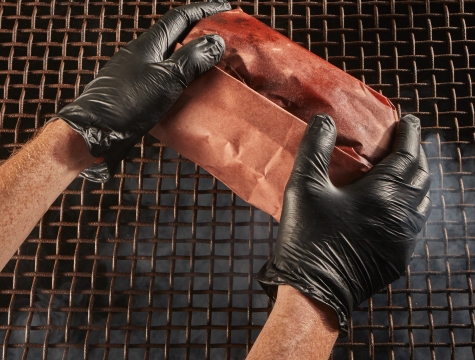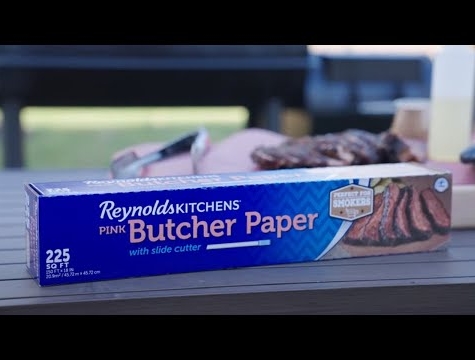How to Smoke Pork Butt Like a BBQ Pro
Discover how to smoke pork butt from the experts. Learn how long to smoke a pork butt, when to wrap pork butt in butcher paper, and other pro tips and tricks.
Last updated: October 18, 2024
Smoking a pork butt is both an art form and a labor of love, promising to deliver tender and flavorful pulled pork every time. Whether you’re hosting a simple family gathering, celebrating a big event, or just kicking back for a weekend feast, pulled pork is a popular choice everyone will enjoy.
For every backyard BBQ enthusiast, learning how to smoke a pork butt is a crucial skill. Get all the details, from choosing the cut of meat to shredding the pork when it’s done.
BOSTON BUTT VS. PORK BUTT VS. PORK SHOULDER: WHAT’S THE DIFFERENCE?
What is a pork butt? Despite its name, pork butt isn’t located anywhere near the rear of the pig. In fact, it’s the thick upper portion of the pig’s shoulder, right behind the head. Why is it called pork butt, then? There are two possible reasons: In Revolutionary New England, pork was stored and shipped in barrels called butts, while others say “butt” means “the widest part” in old English.1, 2 What is a Boston Butt? It’s simply another name for a pork butt, named after the meat-cutting technique that originated in Boston.3
The pork shoulder includes both the pork butt and the picnic shoulder cuts. The picnic shoulder is the lower portion of the pig’s shoulder. It’s typically cut into a triangular shape versus the rectangular shape of a pork butt.
Which cut is best for smoking?
While both cuts come from the shoulder, the taste and texture differ. The pork butt is fattier, making it a more tender and soft meat. Picnic shoulder has less fat, making it slightly tougher and chewier. You can use both cuts in a smoker, but when it comes to pulled pork, the pork butt is the cut of choice. Picnic shoulder is better if you love crispy skin, as it is typically sold with the skin on. Want to try your hand at smoking other meats? Learn how to smoke a brisket.


Smoking Pork Butt with Butcher Paper
YOU'LL NEED...
Pink Butcher Paper with Slide Cutter

Directions:
From start to finish, the total prep time may take about 9-10 hours at a temperature of 275°F, for an 8-pound pork butt, including the rest time before and after cooking. As with all smoking, your cooking time may vary depending on the meat thickness, type of smoker, temperature, distance from the heat, and even the weather. Check your smoker’s manual for applicable cooking instructions before getting started.
- Preheat your smoker to a temperature of 275°F.
- Start with a bone-in 8-pound pork butt.4
- If desired, you can trim a portion of the fat cap on your pork butt to make it less fatty. However, some BBQ pros don’t trim the fat cap because they believe it gives pork butt its best flavor. They only remove fatty edge pieces hanging from the meat to make it easier to apply the rub evenly.5
- Score the fat on top of the pork butt. This allows the fat to render and gets more of the tasty seasoning inside the pork butt to build that delicious and desirable bark.6
- Slather the pork butt with olive oil and then season liberally with salt and pepper, paprika, garlic powder, and other spices you like. You can use different slathers, like mayonnaise, mustard, or oil and vinegar mixes. This allows your dry rub (seasonings) to adhere to the surface of your meat. Feel free to get creative with your dry rubs or use wet rubs (a barbecue sauce) by following a recipe or purchasing from BBQ professionals or your grocery store.
- Let the pork butt rest for about 30 minutes to allow the seasoning to absorb into the meat.
- Place your pork butt, fat side up, on the preheated smoker. Cook for 3 hours untouched.
- After it has smoked for the initial 3 hours, spray the meat with apple cider vinegar, apple juice, or another liquid every hour until the pork butt reaches 165°F inside.
- Once the pork reaches 165°F (approximately 5-6 hours from when you first placed the pork in the smoker), you want to wrap your meat in butcher paper. Another way to tell if your pork butt is ready to wrap is by pressing on top of your pork butt with your gloved finger. It should sink into the fat. See how to wrap your pork butt in butcher paper in the following section.
- Place your wrapped meat back in the smoker and continue to smoke at 275°F.
- For the most tender and easy-to-shred meat, smoke the wrapped pork until it reaches an internal temperature of 200°F to 205°F. The meat temperature is critical, but a rough estimate of smoking time for this stage is about two more hours.
- Rest your pork butt for at least 30 to 60 minutes before pulling the meat. Don’t skip this step! If you don’t wait, your pulled pork will turn out dry.
- With food-safe gloves, pull out the shoulder bone.7
- Use your gloved hands, meat claws, or shredders to pull the meat apart.
- Add more seasoning or barbecue sauce, and get ready to enjoy melt-in-your-mouth pulled pork.4, 5, 7, 8
How to Wrap Pork Butt in Butcher Paper
Wrapping pork butt (or any meat) is a simple technique that every seasoned or first-time smoker should learn to master. When you’re ready to wrap your pork butt in butcher paper, reach for your box of Reynolds Kitchens® Pink Butcher Paper.
Directions:
- For larger cuts like that of a pork butt, cut two sheets of Reynolds Kitchens® Pink Butcher Paper.
- Overlap the two sheets and place your partially cooked meat in the center at one end.
- Wrap the sides of the two sheets over the pork butt, and then wrap the meat like a present, as demonstrated in the video above.

How Long to Smoke Pork Butt Per Pound
- How long does it take to smoke pork butt at 225°F? Smoke time is about 2 hours per pound.9
- How long does it take to smoke pork butt at 250°F? Smoking time is about 90 minutes per pound.8, 10
- How long does it take to smoke pork butt at 275°? Smoking time is about 1 hour per pound.7
How do you know when your pork butt is done?
The USDA says pork is safe to eat at a minimum internal temperature of 145°F. However, pulled pork reaches maximum flavor and fork tenderness at an internal temperature of 200°F to 205°F.
SHREDDING PULLED PORK
You’re approaching the final stretch, ready to savor that long-anticipated, flavorful pulled pork! But first, rest your meat for 30 to 60 minutes before shredding. Don’t skip this step if you want juicy and tasty pulled pork. The rest period allows the moisture to absorb back into the meat. Next, let’s get to the exciting part—how to pull pork.
Here’s how to shred pulled pork: pitmasters and smoker enthusiasts recommend using your hands (with food-safe gloves), two forks, or meat claws. But if you’re in a hurry, you could also use a handheld mixer or a meat shredder drill bit (yes, there’s such a thing!). Remove any bones or big pieces of gristle as you shred the meat.
Frequently Asked Questions About Smoking Pork Butt
WHAT IS PORK BUTT?
The pork butt, also known as the “Boston Butt,” is cut from the upper part of the pig’s shoulder.
WHY IS IT CALLED PORK BUTT?
Agricultural journals suggest the name of the Boston butts refers to the regional area from where they were shipped or “the larger or thicker end of something.” The pork butt is the thicker end of the shoulder cut. Or it could be named after the specialized barrels known as “butts,” in which the meat was shipped and stored.1, 2, 3
IS PORK SHOULDER THE SAME AS PORK BUTT?
Yes and no. Both the pork butt and the picnic shoulder (or picnic roast) are cuts of the pork shoulder. However, some butchers and grocery stores call the picnic shoulder a pork shoulder. Others even call the pork butt a pork shoulder. As you might guess, this can be quite confusing. Work with your butcher to ensure you have the right cut.
The pork butt is a larger, rectangular cut of pork with a lot of connective tissue and fat throughout and a thick fat cap on top. It’s perfect for pulled pork.
The picnic shoulder is a triangular-shaped cut from the lower part of the shoulder, just above the front leg. It’s less fatty than pork butt, so it’s less tender and can be somewhat chewy. One thing that sets pork shoulder apart from pork butt is that pork shoulder usually comes with the skin still on and a layer of fat underneath. Many people enjoy the crispy, smoked skin and the fact that it can be sliced or chopped for serving.3
HOW LONG DOES IT TAKE TO SMOKE A PORK BUTT?
Always use the meat’s internal temperature to gauge its doneness throughout the smoking process. The estimated times below are based on expert insights from seasoned BBQ pitmasters and chefs.
- Smoker temperature of 225°F: about 2 hours per pound
- Smoker temperature of 250°F: about 90 minutes per pound
- Smoker temperature of 275°F: about 1 hour per pound
For example:
How long to smoke a 10 lb butt?
- 225°F: about 20 hours
- 250°F: about 15 hours
- 275°F: about 10 hours
How long to smoke a 5 lb butt?
- 225°F: about 10 hours
- 250°F: about 7.5 hours
- 275°F: about 5 hours
Check your smoker’s manual for applicable cooking instructions before getting started. At what temperature is pork butt done? The USDA says pork is safe to eat at a minimum internal temperature of 145°F.11 But it’s best to smoke the pork to an internal temperature of 200°F to 205°F. You’ll achieve the most optimal flavor and tenderness at this temperature range.
WHICH IS BETTER: PORK BUTT OR SHOULDER FOR PULLED PORK?
Pork butt is better for pulled pork. It has more fat, giving it meat that is more tender, moist, and soft. The pork shoulder (or picnic roast) isn’t as fatty and is better suited for slicing and chopping versus shredding as pulled pork.
CAN YOU USE PORK BUTT FOR PULLED PORK?
Yes. Pork butt is ideal for pulled pork. It has a higher fat content with marbling throughout and a thick fat cap, which renders down in the meat while it cooks. Your results will be tender and succulent, perfect for pulled pork sandwiches and tacos or topping nachos and mac-and-cheese.

Related Articles



Resources:
1 Sontag, E. (2023, October 23). Pork Shoulder Demystified: Boston Butt versus Picnic Shoulder. Serious Eats.
2 Moss, R. (2023, September 23). What Is Boston Butt and How Did It Get That Name? Southern Living.
3 Khoury-Hanold, L. (2022, June 10). Pork Butt vs. Pork Shoulder: What’s the Difference? Food Network.
4 Yoder, J. (2021, January 9). How to Smoke Pork Butt/How to Make Pulled Pork Recipe. Mad Scientist BBQ YouTube Channel.
5 Franklin, A. (2013, March 1). BBQ with Franklin: Pulled Pork. BBQ with Franklin YouTube Channel.
6 Bartlow, S. (2023, July 17). Pork Shoulder Scoring How To. Bartlow’s BBQ YouTube Channel.
7 Lane, R. (2021, February 18). Beginner’s Guide to Smoking a Pork Butt. Lane’s BBQ.
8 Parisi, B. (2022, April 4). Smoked Pulled Pork Shoulder (Pork Butt) Video Recipe. Chef Billy Parisi.
9 Bulloch, S. (2023, October 24). Simple Smoked Pulled Pork Butt (Smoked Pork Shoulder). Hey Grill Hey.
10 Duong, E. How Long to Smoke a Pork Butt at 250°F. Edith’s Bistro.
11 Fresh Pork from Farm to Table. USDA Food Safety.



